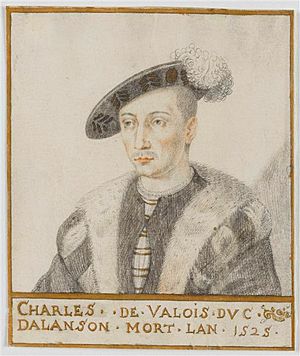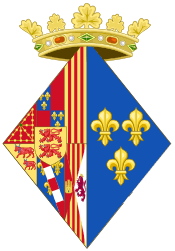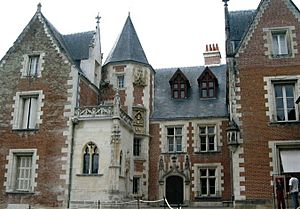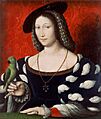Marguerite de Navarre facts for kids
Quick facts for kids Marguerite de Navarre |
|
|---|---|
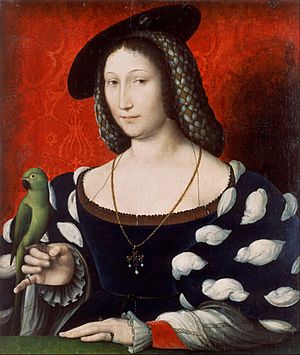
Portrait attributed to Jean Clouet, c. 1527
|
|
| Queen consort of Navarre | |
| Tenure | 24 January 1527 – 21 December 1549 |
| Born | 11 April 1492 Angoulême, Angoumois, France |
| Died | 21 December 1549 (aged 57) Odos, Gascony, France |
| Spouse | |
| Issue | Jeanne III of Navarre Jean of Navarre |
| House | Valois-Angoulême |
| Father | Charles, Count of Angoulême |
| Mother | Louise of Savoy |
| Religion | Roman Catholicism |
Marguerite de Navarre (born Marguerite d'Angoulême, also known as Marguerite d'Alençon; 11 April 1492 – 21 December 1549) was a very important princess of France. She became the Duchess of Alençon and Berry. Later, she became the Queen of Navarre when she married King Henry II of Navarre.
Marguerite's brother became King Francis I of France. Together, they created a famous court where smart people, artists, and writers gathered. Marguerite is an ancestor of the Bourbon kings of France. Her daughter, Jeanne d'Albret, was the mother of Henry IV of France, who became the first Bourbon king. Marguerite was also a talented writer and supported many thinkers and reformers during the exciting time of the French Renaissance. Some people even called her "The First Modern Woman."
Contents
Growing Up in France
Marguerite was born in Angoulême, France, on April 11, 1492. She was the oldest child of Louise of Savoy and Charles, Count of Angoulême. Her father was related to King Charles V. This meant he was next in line for the French crown if the current king and his heir had no sons.
When Marguerite was two, her family moved to Cognac. This town was very influenced by Italian culture. Writers like Giovanni Boccaccio were very popular there. Marguerite also had several half-brothers and sisters. They were raised with her and her brother.
Marguerite's mother, Louise, made sure her children received an excellent education. Marguerite learned many classical subjects, including Latin. People later called her a "Maecenas" (a supporter of arts and learning) for the smart people in her brother's kingdom. When Marguerite was ten, her mother tried to arrange a marriage for her with the Prince of Wales, who would become Henry VIII of England. However, this marriage did not happen. Marguerite might have been in love with Gaston of Foix, Duke of Nemours. But Gaston died as a hero in Italy during a battle.
Her First Marriage
At seventeen, Marguerite married Charles IV of Alençon, who was twenty. King Louis XII arranged this marriage for political reasons. Marguerite was a bright young princess, but she had to marry a man who was not very educated. This marriage helped keep the County of Armagnac within the royal family. Marguerite and Charles did not have any children together.
When her brother, Francis I, became king in 1515, Marguerite became one of the most important women in France. Her home became a famous meeting place for intellectuals and artists. It was known as the "New Parnassus." After Queen Claude died, Marguerite also took care of her two nieces, Madeleine and Margaret of France, Duchess of Berry. She continued to care for them even after her second marriage.
Her Children
Marguerite was married twice. Her first marriage to Charles IV of Alençon did not result in any children.
Her second marriage was to Henry II of Navarre. They had two children:
- Jeanne III of Navarre (born November 16, 1528 – died June 9, 1572). She became the Queen regnant of Navarre from 1555 to 1572. Jeanne was the mother of Henry IV of France, who became King of Navarre and later the first Bourbon King of France. Jeanne was also a strong leader of the French Huguenot (Protestant) movement.
- Jean (born July 7, 1530 – died December 25, 1530). He sadly died as a baby.
After her first husband died in 1525, Marguerite married Henry II of Navarre. At that time, much of Navarre had been taken over by Spain. So, Henry ruled only a part of Navarre and some other areas. About a year after her portrait was painted by Jean Clouet, Marguerite gave birth to her daughter, Jeanne III of Navarre, on November 16, 1528. Jeanne would later become the mother of King Henry IV of France.
A diplomat from Venice once said that Marguerite knew all the secrets of diplomacy. This meant she was very skilled in dealing with other countries. One of Marguerite's most amazing achievements was helping to free her brother, King Francis I. He had been captured by Charles V, Holy Roman Emperor in Italy in 1525 and held prisoner in Spain. During the important talks to free him, Queen Marguerite rode a horse for twelve hours a day through snowy forests. She had to meet a deadline for a safe journey. At night, she would write important diplomatic letters.
Her only son, Jean, was born in Blois on July 7, 1530. Marguerite was thirty-eight years old. Sadly, the child died on Christmas Day that same year. Many scholars believe that her deep sadness led Marguerite to write her most talked-about work, Miroir de l'âme pécheresse (Mirror of the Sinful Soul), in 1531.
Some religious scholars at the Sorbonne university said her work was against their beliefs. One monk even suggested she should be thrown into the Seine river. Students made fun of her in a play. However, her brother, King Francis I, made sure the accusations were dropped. He also got an apology from the Sorbonne.
A Talented Writer
Marguerite wrote many poems and plays. Her most famous works are a collection of short stories called Heptameron. She also wrote a very powerful religious poem, Miroir de l'âme pécheresse. This poem is a personal story about a soul, like a woman, calling out to Christ. Her writings even reached the royal court of England. This shows that Marguerite had an impact on the Protestant Reformation in England.
Her Role in the Reformation
After John Calvin and William Farel were forced to leave Geneva in 1538, Marguerite de Navarre wrote to Marie Dentière. Marie was a well-known Protestant reformer in Geneva. The two women knew each other personally. Marguerite was even the godmother to Marie Dentière's daughter. In her letter, Marguerite asked why Calvin and Farel had been expelled. Marie Dentière replied in 1539 with a letter called Epistle to Marguerite de Navarre. This letter criticized the Protestant leaders who had expelled Calvin and Farel. It also asked for Marguerite's help in getting more women to read and understand the Bible. It advised her to work on removing Catholic clergy from France.
While Anne Boleyn was in France, she was a lady-in-waiting to Queen Claude. It is thought that Anne might have also spent time with Marguerite. Anne may have learned about Marguerite's Christian views. A letter from Anne Boleyn, after she became queen, shows her strong affection for Marguerite.
It is believed that Marguerite gave Anne the original manuscript of Miroir de l'âme pécheresse. What is certain is that in 1544, Anne's daughter, Elizabeth I (who would become queen), translated the poem into English. Elizabeth was eleven years old at the time. She wrote it in her own hand and gave it to her stepmother, Queen Katherine Parr. This connection between Marguerite, Anne Boleyn, Katherine Parr, and Elizabeth suggests a direct link of reformist religious ideas.
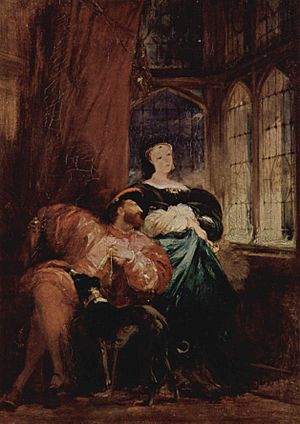
Supporting the Arts
Marguerite was a very generous supporter of the arts. She became friends with and protected many artists and writers. These included François Rabelais, Clément Marot, Claude de Bectoz, and Pierre de Ronsard. Marguerite also tried to help find common ground between Roman Catholics and Protestants, including John Calvin. Even though Marguerite wanted to see changes within the Catholic Church, she was not a Calvinist. She did her best to protect reformers and tried to stop her brother, Francis I, from taking harsh actions against them for as long as she could. After her death, France experienced eight religious wars. A terrible event called the St. Bartholomew's Day Massacre happened in 1572.
The famous artist Leonardo da Vinci (1452–1519) died while he was a guest of Marguerite and her brother, Francis I. Marguerite and Francis grew up at Château d'Amboise. The king lived there, and Marguerite had a home nearby. Leonardo had designed a large castle for them, among other projects. They gave him a place to live when he left Italy and joined their court. As a guest of the king, Leonardo da Vinci came to Château Amboise in December 1515. He lived and worked in a nearby house called Clos Lucé, which was connected to the château by an underground passage. Visitors are told that he is buried in the Chapel of Saint-Hubert, next to the Château.
Her Lasting Impact
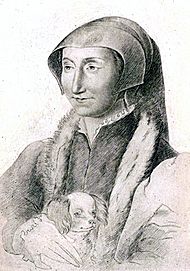
Pierre Brantôme, a writer, said about her: "She was a great princess. But more than that, she was very kind, gentle, graceful, charitable, a great giver of help, and friendly to everyone."
The Dutch scholar Erasmus wrote to her: "For a long time I have admired all the many wonderful gifts God gave you. These include wisdom, purity, moderation, faith, incredible strength, and a wonderful disregard for all the unimportant things in this world. Who wouldn't admire such qualities in a great king's sister? These are rare even among priests and monks."
In 1550, a year after Marguerite died, a poem was published in England to honor her. It was written by the nieces of Jane Seymour, who was the third wife of King Henry VIII.
American historian Will Durant wrote: "In Marguerite, the Renaissance and the Reformation came together for a moment. Her influence spread throughout France. Every free-thinking person saw her as a protector and an ideal. Marguerite was the perfect example of kindness. She would walk alone in the streets of Navarre. She allowed anyone to approach her and would listen directly to the people's problems. She called herself 'The Prime Minister of the Poor.' Her husband, King Henri of Navarre, believed in what she was doing. He even set up a public works system that became a model for France. Together, he and Marguerite paid for the education of students who needed help."
Jules Michelet, a famous historian, wrote about her: "Let us always remember this kind Queen of Navarre. In her arms, our people, fleeing from prison or fire, found safety, honor, and friendship. We are grateful to you, Mother of our [French] Renaissance! Your home was a haven for our saints, your heart the nest of our freedom."
Pierre Bayle, a French philosopher, greatly respected her. He wrote: "... for a queen to protect people who are being punished for beliefs she thinks are wrong; to offer them a safe place; to save them from being burned; to provide them with food; to generously help them with the troubles of their exile, is an incredibly brave act that has almost no example before it..."
Images for kids
-
Portrait attributed to Jean Clouet, c. 1527
See also
 In Spanish: Margarita de Angulema para niños
In Spanish: Margarita de Angulema para niños


